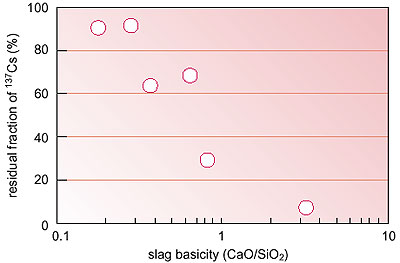Low-level radioactive solid wastes arising from nuclear facilities consist of diverse materials having varied contamination, as shown in Fig. 11-5.A melting treatment of such solid wastes by plasma heating is one of the most effective treatment processes.
The major advantages of the melting treatment are that it has a high volume-reduction ratio and it effectively immobilizes radionuclides. Furthermore, the homogeneous distribution of radionuclides in the resulting solidified products enable us to determine the radioactive inventory in a whole waste package by examining only small samples collected from the molten wastes.
To advance melting techniques, we have conducted plasma-melting tests (Fig. 11-5).
As a result of investigating optimum combinations of various waste materials, melting order, and so on, we determined that wastes with a higher melting point, like thermal insulator, could be processed to obtain satisfactory fluidity without the addition of flux or a great increase in melting temperature to achieve optimum melting conditions. During melting, nonmetallic and metallic wastes separated into layers according to their specific gravitates. We also confirmed that radionuclides were uniformly distributed within the slag and metallic layers. Moreover, the transfer behavior of 137Cs, a representative volatile radionuclide, in the slag layer was influenced by the chemical composition of the slag (Fig. 11-6).
These results will greatly contribute to the operation of the Waste Volume Reduction Facilities, under construction at JAERI, from the standpoints of realization of a high volume-reduction ratio for wastes, suppression of corrosion of refractory materials in the melting furnace, and prediction of the distribution of radionuclides. |


